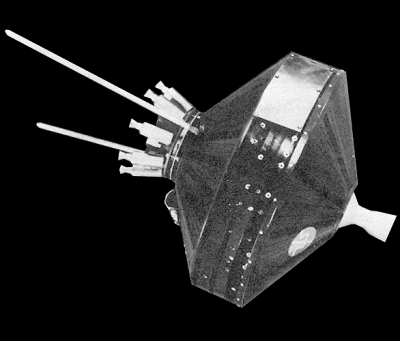Pioneer 10 (originally designated Pioneer F) is an American space probe, launched in 1972 and weighing 260 kilograms (570 pounds), that completed the first mission to the planet Jupiter. Thereafter, Pioneer 10 became the first of five artificial objects to achieve the escape velocity needed to leave the Solar System. This space exploration project was conducted by the NASA Ames Research Center in California. The space probe was manufactured by TRW Inc.
Pioneer 10 was assembled around a hexagonal bus with a 2.74-meter (9 ft 0 in) diameter parabolic dish high-gain antenna, and the spacecraft was spin stabilized around the axis of the antenna. Its electric power was supplied by four radioisotope thermoelectric generators that provided a combined 155 watts at launch.
It was launched on March 3, 1972 at 01:49:00 UTC (March 2 local time), by an Atlas-Centaur expendable vehicle from Cape Canaveral, Florida. Between July 15, 1972, and February 15, 1973, it became the first spacecraft to traverse the asteroid belt. Photography of Jupiter began November 6, 1973, at a range of 25,000,000 kilometers (16,000,000 mi), and about 500 images were transmitted. The closest approach to the planet was on December 3, 1973, at a range of 132,252 kilometers (82,178 mi). During the mission, the on-board instruments were used to study the asteroid belt, the environment around Jupiter, the solar wind, cosmic rays, and eventually the far reaches of the Solar System and heliosphere.Radio communications were lost with Pioneer 10 on January 23, 2003, because of the loss of electric power for its radio transmitter, with the probe at a distance of 12 billion kilometers (80 AU) from Earth.
The Pioneer programs were two series of United States lunar and planetary space probes exploration. The first program, which ran from 1958 to 1960, unsuccessfully attempted to send spacecraft to orbit the Moon, successfully sent one spacecraft to fly by the Moon, and successfully sent one spacecraft to investigate interplanetary space between the orbits of Earth and Venus. The second program, which ran from 1965 to 1992, sent four spacecraft to measure interplanetary space weather, two to explore Jupiter and Saturn, and two to explore Venus. The two outer planet probes, Pioneer 10 and Pioneer 11, became the first of five artificial objects to achieve the escape velocity that will allow them to leave the Solar System, and carried a golden plaque each depicting a man and a woman and information about the origin and the creators of the probes, in case any extraterrestrials find them someday.

1973Dec, 3
Pioneer program: Pioneer 10 sends back the first close-up images of Jupiter.
Choose Another Date
Events on 1973
- 20Jul
Bruce Lee
Bruce Lee, the famous Chinese actor and martial-arts expert, dies in Los Angeles at age 32 from a brain edema possibly caused by a reaction to a prescription painkiller. - 15Aug
Cambodia
Vietnam War: The United States bombing of Cambodia ends. - 22Aug
Salvador Allende
The Congress of Chile votes in favour of a resolution condemning President Salvador Allende's government and demands that he resign or else be unseated through force and new elections. - 17Oct
1973 oil crisis
OPEC imposes an oil embargo against a number of Western countries, considered to have helped Israel in its war against Egypt and Syria. - 4Nov
1973 oil crisis
The Netherlands experiences the first Car-Free Sunday caused by the 1973 oil crisis. Highways are used only by cyclists and roller skaters.

 English
English  español
español  français
français  português
português  русский
русский  العربية
العربية  简体中文
简体中文 